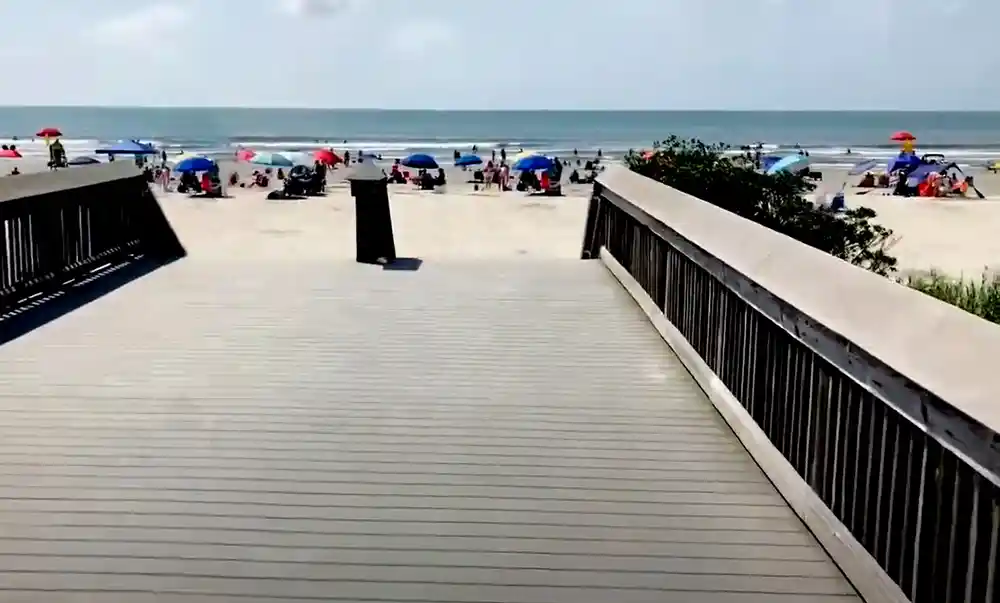
The IOP County Park Beach public beach access draws many day visitors, but numbers may soon become too big for island space and resources to handle without controls.
When Mount Pleasant Realtor Cynthia Williams listed her first home on the Isle of Palms in 2014, there was only so much land and space to go around for new homes, new businesses and new short-term rentals.
“But now there’s so much more of everything – restaurant choices, rentals, amenities, a fully renovated marina, plus people and traffic,” said Williams, broker-in-charge of Lifestyle Real Estate. “It just shows how much in demand the island has become for both residents and visitors.”
And based on current numbers and trends, that demand is not only expected to grow even more through the rest of the 2020s, but also presents a quandary for IOP leaders and residents: How to keep population numbers under control while maintaining the island’s destination as a longtime vacation hub.
“I am particularly interested in the next generations and what we’re leaving behind for them as a livable community,” said IOP Chamber Vice President Rod Turnage. “Growth is a major topic right now, as we only have so much land to support it.”
But unless a major change in the next decade or so unexpectedly affects the island’s longstanding draw in tourism, the demand for its lifestyle, weather, beaches and charm is projected to continue a steady climb.
Resident numbers alone are indicative The U.S. Census Bureau estimates that the number of permanent residents in the past 12-13 years has grown 5.4% – from approximately 4,133 in 2010 to 4,357 in 2022.
This equates to about 981 people for each square mile of land – more than three times the density for all of Charleston County’s metropolitan area, whose 830,000-plus residents are spread over three counties and approximately 3,161 square miles.
But while Charleston County still has plenty of room to house more people, Isle of Palms doesn’t. The island’s entire land space encompasses only 4.44 square miles – plus 1 square mile of water.
Yet, recent reports by the Charleston Trident Association of Realtors (CTAR) show that the number of people coming to the island – whether permanent or visitor – is expected to keep increasing at least through the mid-2030s.
CTAR’s local market updates for 2022 show that new construction on the island was up 5.3% over 2021 – higher than all of nearby Colleton County’s 1,133 square miles put together.
“And that’s primarily lots with old island houses that are being replaced with other new homes built on the same site,” said IOP City Councilman Blair Hahn.
Median home prices for 2022 were up as well – from an average of $1.25 million to $1.48 million – 18.8% higher than 2021, and a whopping 93.6% higher than as recent as 2018.
“When I first came to the island in 2013, prices just for condos in Wild Dunes were $600,000-$700,000,” Williams said. “Now they’re over $1 million.”
And by 2035, the South Carolina Revenue and Fiscal Affairs Office in Columbia estimates that Charleston County alone will be home to 448,125 people – approximately 6.88% higher than its current population of 419,279.
If interest in Isle of Palms were to keep pace with this estimate, its population would easily exceed 4,600 – which would mean fitting at least 300 more people into the same amount of current livable space. And these projections don’t include daily and yearly visitors.
“The amount of regional growth we’ve experienced in the past five-10 years has had a significant impact on the number of day visitors to the island,” said Kathryn Basha, planning director with the Berkeley-Charleston- Dorchester Council of Governments. “And this is an issue that city leaders are already grappling with in terms of parking and traffic.”
At the height of IOP’s summer tourist season, vacationers number as high as 20,000 per day – more than four times the number of permanent residents. And these numbers are expected to keep rising.
“Our day visitors are going to be the real issue,” Hahn said. “The Charleston metro area is fast approaching 1 million people and expected to keep rising. With this regional growth, IOP will have more and more day visitors, and we are going to have to deal with this in a way that benefits residents and visitors alike.”
Which means the big question for IOP residents and leaders may soon become: What are our limits on daily and permanent populations and how will we control them?
“From my standpoint, I think we have to balance what we have,” Turnage added. “And going forward, we will have to look at what is sustainable for the island and its residents.”
By L. C. Leach III




Leave a Reply